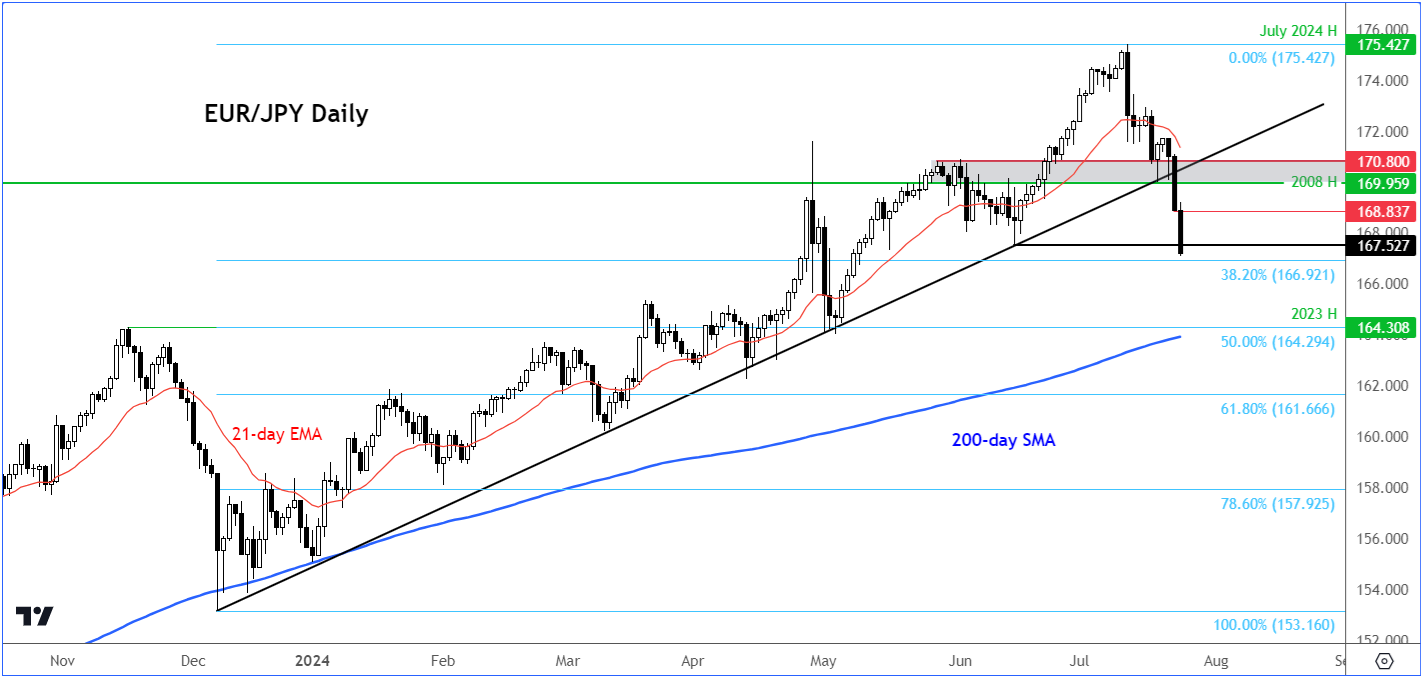The US dollar continued to weaken against the Japanese yen and Swiss franc this morning, but it has gained against other major currencies.
The euro, in particular the EUR/JPY pair, has been hit hard falling for a second consecutive day following disappointing eurozone PMI data.
The yen, on the other hand, is on a rally as Japanese bond yields rise while those in the US and Eurozone fall.
Market watchers are now focused on the upcoming Bank of Japan meeting, with speculation mounting about a potential ten-basis point rate hike.
The yen's recovery from earlier declines this year contrasts sharply with the euro's struggle this week, as poor data further weakens the EUR/JPY and holds back EUR/USD.
In the FX space, the focus will turn to upcoming data on the economic calendar.
Eurozone's Recovery Falters on Weak PMI Data
July's PMI data suggests the eurozone's economic recovery is losing momentum. The composite index fell to 50.1 from 50.8 in June, barely above the expansion-contraction threshold. Manufacturing PMI dropped to 45.6, signaling ongoing weakness, while services PMI dipped to 51.9.
Rising input costs also pose inflationary challenges. Country-specific data shows France's PMI improving slightly but still below 50 due to weak manufacturing sentiment, while Germany's PMI fell sharply below 50, reflecting deteriorating conditions in both sectors.
Eurozone Growth Outlook Darkens as Yen Strengthens Amid Rising Yields
ECB President Christine Lagarde recently acknowledged that risks to the eurozone's growth outlook have shifted to the downside. While PMIs are not the only growth indicators, the latest data highlights the sluggish recovery, negatively impacting the EUR/JPY.
In contrast to the euro, the yen continues to strengthen, driven by rising Japanese yields compared to falling global yields. This trend reflects a narrowing bond yield spread after years of expansionary policy in Japan and contractionary measures elsewhere.
With central banks globally beginning or planning rate cuts, and Japan tightening, attention is on the Bank of Japan's upcoming meeting, with speculations of a ten-basis point rate hike. The yen's recovery has reduced the need for government intervention in the FX space.
USD Mixed Ahead of Key US Data
The US dollar remains mixed, weakening against the yen and franc but strengthening against other currencies, including the euro. While the EUR/USD has weakened, it could benefit from potential broad dollar declines.
The market currently prices a 98% chance of a rate cut in September. Upcoming economic data, including PMIs, GDP, and Core PCE, will be critical in shaping market expectations for further rate cuts beyond September.
US Presidential Race Adds Uncertainty
The US presidential race adds another layer of uncertainty. Joe Biden's exit has cast doubts on the dollar's future and risk assets. The competition between Harris and Trump is expected to be close, likely impacting the dollar.
Currently, the dollar is down against the yen but up against commodity currencies amid concerns over China's economic health. Let’s see if its trajectory will change depending on how opinion polls change in the US presidential race.
Still, the Federal Reserve's interest rate decisions remain the main driver for the dollar. Investors are confident that the Fed will begin cutting rates in September, regardless of the election outcome.
The dollar might start to decline more broadly once concerns about China subside, shifting focus back to economic data.
EUR/JPY Technical Analysis and Trade Ideas
The yen's resurgence has caused key support levels in EUR/JPY to break, putting the pair on a bearish trajectory. EUR/JPY has fallen over 800 pips from its July high of 175.42, with significant selling pressure in recent sessions.

The breakdown of the bullish trend line this week has undoubtedly triggered numerous stop orders positioned just below that trend line. Interestingly, this trend line break occurred near the same level as the 2008 high, just below the 170 handle. Given the historical significance of this level, selling has accelerated over the last two trading sessions.
In terms of support and resistance levels to watch, there are plenty of big levels approaching.
For potential support, the 38.2% Fibonacci retracement from the rally that began in December is at 166.92. Below this, the next key level is 164.30, which aligns with the 2023 high and the 50% retracement level.
The proximity of the 200-day moving average to the 164.00 handle also makes this area a significant support zone. However, whether the price will reach this level remains uncertain.
On the upside, the 169.95–170.00 range will now serve as a crucial resistance zone if there's a recovery in the coming days. Before reaching this zone, interim resistance levels to watch include the June low of 167.52 and Tuesday’s low at 168.83.
Disclaimer: This article is written for informational purposes only; it does not constitute a solicitation, offer, advice, or recommendation to invest as such it is not intended to incentivize the purchase of assets in any way. I would like to remind you that any type of asset, is evaluated from multiple points of view and is highly risky and therefore, any investment decision and the associated risk remains with the investor.
